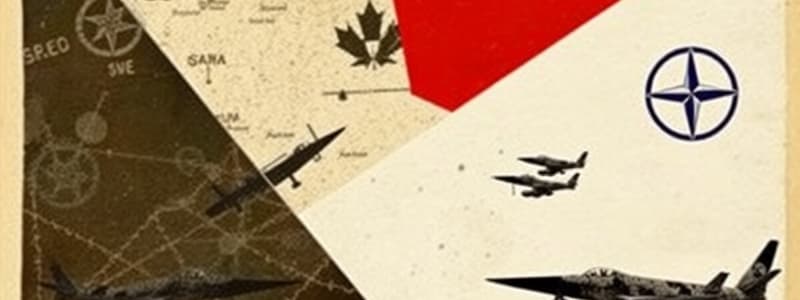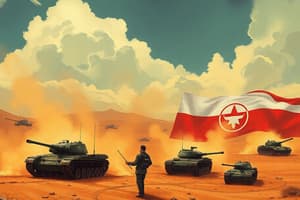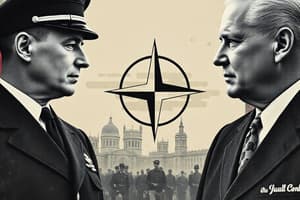Podcast
Questions and Answers
What was the main purpose of NATO when it was established in 1949?
What was the main purpose of NATO when it was established in 1949?
- To protect Western European countries from potential aggression from the USSR. (correct)
- To facilitate trade agreements between member nations.
- To expand military presence in Eastern Europe.
- To promote economic cooperation among Western European countries.
What was Canada's commitment to NATO?
What was Canada's commitment to NATO?
- To establish a military base in Eastern Europe.
- To maintain a full army brigade and engage only in defensive operations.
- To keep a full army brigade and several air squadrons in Europe. (correct)
- To focus solely on naval defense capabilities.
What was the main response of the Soviet Union to the admission of West Germany into NATO?
What was the main response of the Soviet Union to the admission of West Germany into NATO?
- To increase economic sanctions against Western nations.
- To engage in dialogue with NATO members.
- To initiate the Warsaw Pact in 1955. (correct)
- To withdraw from all military alliances.
What was NORAD's primary purpose when it was initially established?
What was NORAD's primary purpose when it was initially established?
How did Canada's joining NATO impact its defense policy?
How did Canada's joining NATO impact its defense policy?
Which countries were part of the Warsaw Pact?
Which countries were part of the Warsaw Pact?
What is the DEW line primarily associated with?
What is the DEW line primarily associated with?
What was the main purpose of the United Nations Emergency Force (UNEF) created during the Suez Crisis?
What was the main purpose of the United Nations Emergency Force (UNEF) created during the Suez Crisis?
What was one significant action taken by Fred Rose related to espionage?
What was one significant action taken by Fred Rose related to espionage?
Which Canadian political leader opposed the British and French military intervention during the Suez Crisis?
Which Canadian political leader opposed the British and French military intervention during the Suez Crisis?
Which ideology did the Vietnam War primarily center around?
Which ideology did the Vietnam War primarily center around?
What was a significant consequence for American men during the Vietnam War regarding conscription?
What was a significant consequence for American men during the Vietnam War regarding conscription?
What stance did Canada take regarding military involvement in the Vietnam War?
What stance did Canada take regarding military involvement in the Vietnam War?
What was the public opinion in Canada regarding the Vietnam War?
What was the public opinion in Canada regarding the Vietnam War?
Who was the leader of North Vietnam during the Vietnam War?
Who was the leader of North Vietnam during the Vietnam War?
What was one of the unique aspects of Canada's immigration policy regarding draft dodgers from the Vietnam War?
What was one of the unique aspects of Canada's immigration policy regarding draft dodgers from the Vietnam War?
What year was the Canadian Bill of Rights enacted?
What year was the Canadian Bill of Rights enacted?
What major change did the Canadian Charter of Rights and Freedoms bring about in 1982?
What major change did the Canadian Charter of Rights and Freedoms bring about in 1982?
What was one significant outcome of the Massey Commission established in 1949?
What was one significant outcome of the Massey Commission established in 1949?
Which agency was created in 1968 to regulate broadcasting content in Canada?
Which agency was created in 1968 to regulate broadcasting content in Canada?
What was a key feature of the Canadian multiculturalism policy introduced in 1971?
What was a key feature of the Canadian multiculturalism policy introduced in 1971?
What issue did the White Paper of 1969 aim to address?
What issue did the White Paper of 1969 aim to address?
What did the Canadian Citizenship Act of 1947 achieve?
What did the Canadian Citizenship Act of 1947 achieve?
How did the introduction of the Canadian Multiculturalism Act in 1988 aim to influence society?
How did the introduction of the Canadian Multiculturalism Act in 1988 aim to influence society?
What was one of the measures taken to promote Canadian culture as outlined by the Massey Commission?
What was one of the measures taken to promote Canadian culture as outlined by the Massey Commission?
Which change regarding First Nations peoples was made to the Indian Act in 1951?
Which change regarding First Nations peoples was made to the Indian Act in 1951?
What was a result of Indigenous people winning the right to vote in 1960?
What was a result of Indigenous people winning the right to vote in 1960?
What societal change was indicated by the term 'mosaic' in the context of multiculturalism in Canada?
What societal change was indicated by the term 'mosaic' in the context of multiculturalism in Canada?
What was a major reason why Canadians in the 1950s identified more with American culture?
What was a major reason why Canadians in the 1950s identified more with American culture?
Which organization was created to fund Canadian artists and support the arts?
Which organization was created to fund Canadian artists and support the arts?
What sociopolitical issue did Indigenous peoples begin to organize around in the late 1960s?
What sociopolitical issue did Indigenous peoples begin to organize around in the late 1960s?
In what way did the Indian Act maintain control over Indigenous peoples after the 1951 changes?
In what way did the Indian Act maintain control over Indigenous peoples after the 1951 changes?
What was one of the main recommendations of the White Paper regarding Indigenous peoples' lands?
What was one of the main recommendations of the White Paper regarding Indigenous peoples' lands?
What did Indigenous groups demand as a response to the White Paper?
What did Indigenous groups demand as a response to the White Paper?
When did the last residential school in Canada close?
When did the last residential school in Canada close?
Which Canadian Prime Minister issued a public apology for the residential schools on June 11, 2008?
Which Canadian Prime Minister issued a public apology for the residential schools on June 11, 2008?
What was the role of the Berger Commission in the 1970s?
What was the role of the Berger Commission in the 1970s?
What strategy was emphasized in the White Paper to address the issues faced by Indigenous peoples?
What strategy was emphasized in the White Paper to address the issues faced by Indigenous peoples?
Which document presented by Indigenous groups countered the White Paper?
Which document presented by Indigenous groups countered the White Paper?
Which apology was issued in 2022 on behalf of the Catholic Church?
Which apology was issued in 2022 on behalf of the Catholic Church?
What is the purpose of the notwithstanding clause in the Canadian Constitution?
What is the purpose of the notwithstanding clause in the Canadian Constitution?
Why did Rene Levesque oppose the amending of the Constitution?
Why did Rene Levesque oppose the amending of the Constitution?
What was included in the Canada Act passed in 1982?
What was included in the Canada Act passed in 1982?
What proposal did Mulroney introduce at the Meech Lake conference?
What proposal did Mulroney introduce at the Meech Lake conference?
What was a key criticism of the Meech Lake Accord?
What was a key criticism of the Meech Lake Accord?
What significant event occurred regarding constitutional amendments in October 1992?
What significant event occurred regarding constitutional amendments in October 1992?
What was the outcome of the 1995 Quebec Referendum on sovereignty?
What was the outcome of the 1995 Quebec Referendum on sovereignty?
What requirement did the Clarity Act impose on separatist referendums?
What requirement did the Clarity Act impose on separatist referendums?
Which province was particularly in favor of the Meech Lake Accord?
Which province was particularly in favor of the Meech Lake Accord?
What was a major reason for the decline in support for separatism near the end of the century?
What was a major reason for the decline in support for separatism near the end of the century?
Flashcards
NATO (North Atlantic Treaty Organization)
NATO (North Atlantic Treaty Organization)
A military alliance formed in 1949 by Canada, the US, Britain and other Western nations to protect Western Europe from potential Soviet aggression after WWII. An attack on one NATO member is considered an attack on all.
Warsaw Pact
Warsaw Pact
A military alliance initiated by the Soviet Union in 1955 in response to West Germany joining NATO. This alliance aimed to counter NATO with communist Eastern European countries.
NORAD (North American Aerospace Defense Command)
NORAD (North American Aerospace Defense Command)
A joint Canadian and American defense organization established to protect North American airspace. Initially focused on Soviet activities, it now focuses on aerospace warning, control, and maritime warning.
DEW Line (Distant Early Warning Line)
DEW Line (Distant Early Warning Line)
Signup and view all the flashcards
Avro Arrow
Avro Arrow
Signup and view all the flashcards
United Nations (UN)
United Nations (UN)
Signup and view all the flashcards
Canada's involvement in NATO
Canada's involvement in NATO
Signup and view all the flashcards
Canada's involvement in NORAD
Canada's involvement in NORAD
Signup and view all the flashcards
The Vietnam War
The Vietnam War
Signup and view all the flashcards
Conscription
Conscription
Signup and view all the flashcards
Post-War Technological Advancements
Post-War Technological Advancements
Signup and view all the flashcards
Draft Dodgers
Draft Dodgers
Signup and view all the flashcards
The Suez Crisis
The Suez Crisis
Signup and view all the flashcards
Canadian Public Opinion on the Suez Crisis
Canadian Public Opinion on the Suez Crisis
Signup and view all the flashcards
Lester Pearson's Peacekeeping Proposal
Lester Pearson's Peacekeeping Proposal
Signup and view all the flashcards
United Nation Emergency Force (UNEF)
United Nation Emergency Force (UNEF)
Signup and view all the flashcards
Massey Commission
Massey Commission
Signup and view all the flashcards
CRTC
CRTC
Signup and view all the flashcards
Canadian Citizenship Act
Canadian Citizenship Act
Signup and view all the flashcards
Indian Act
Indian Act
Signup and view all the flashcards
CBC
CBC
Signup and view all the flashcards
Canada Council for the Arts
Canada Council for the Arts
Signup and view all the flashcards
National Film Board (NFB)
National Film Board (NFB)
Signup and view all the flashcards
Americanization of Canadian Culture
Americanization of Canadian Culture
Signup and view all the flashcards
White Paper
White Paper
Signup and view all the flashcards
Red Paper
Red Paper
Signup and view all the flashcards
Residential Schools
Residential Schools
Signup and view all the flashcards
Berger Commission
Berger Commission
Signup and view all the flashcards
Self-Government
Self-Government
Signup and view all the flashcards
Truth and Reconciliation Commission
Truth and Reconciliation Commission
Signup and view all the flashcards
Reconciliation
Reconciliation
Signup and view all the flashcards
Indigenous Land Rights & Resource Management
Indigenous Land Rights & Resource Management
Signup and view all the flashcards
What was the Canadian Bill of Rights?
What was the Canadian Bill of Rights?
Signup and view all the flashcards
What is the Canadian Charter of Rights and Freedoms?
What is the Canadian Charter of Rights and Freedoms?
Signup and view all the flashcards
What is Canadian Multiculturalism?
What is Canadian Multiculturalism?
Signup and view all the flashcards
Notwithstanding Clause
Notwithstanding Clause
Signup and view all the flashcards
What was the White Paper of 1969?
What was the White Paper of 1969?
Signup and view all the flashcards
Meech Lake Accord
Meech Lake Accord
Signup and view all the flashcards
What were the residential schools?
What were the residential schools?
Signup and view all the flashcards
Charlottetown Accord
Charlottetown Accord
Signup and view all the flashcards
What was the Berger Commission?
What was the Berger Commission?
Signup and view all the flashcards
1995 Quebec Referendum
1995 Quebec Referendum
Signup and view all the flashcards
What was the Oka Crisis?
What was the Oka Crisis?
Signup and view all the flashcards
Clarity Act
Clarity Act
Signup and view all the flashcards
Describe the challenges faced by Indigenous people in Canada.
Describe the challenges faced by Indigenous people in Canada.
Signup and view all the flashcards
Jacques Parizeau
Jacques Parizeau
Signup and view all the flashcards
Study Notes
Cold War Origins and Characteristics
- The Cold War was a period of tension and hostility between the Soviet Union and the United States, lasting from approximately 1945 to 1991.
- It involved ideological conflict between communist and capitalist systems.
- The Soviet Union's expansion into Eastern Europe after World War II led to concerns in the West about communist intentions.
- The United States viewed this expansion as evidence of Soviet global ambitions.
- The Cold War was characterized by an arms race and proxy wars, avoiding direct conflict between the superpowers.
Soviet Union and the U.S. Political and Economic Systems
- The Soviet Union's political and economic system was communist, characterized by government control over all aspects of industry and commerce.
- Individual liberties were suppressed, and political dissent was not tolerated.
- The U.S. political and economic system was capitalist, emphasizing private enterprise and individual freedoms, including freedom of speech and the press.
Division of Germany
- Post-World War II, Germany was divided into West Germany (capitalist) and East Germany (communist).
- The division was significantly symbolized by the Berlin Wall.
- West Germany experienced economic prosperity, while individuals in East Germany had restricted freedoms.
Igor Gouzenko and Impact on Canada
- Igor Gouzenko, a Soviet embassy cipher clerk, leaked Soviet documents in 1945, revealing extensive espionage activities in Canada.
- His actions raised significant suspicion towards the Soviets.
- This raised awareness of communist infiltration and led to significant political changes and shifts in the Canadian population's perception of the Soviets.
NATO, Warsaw Pact, NORAD, and DEW Line
- NATO (North Atlantic Treaty Organization) was a military alliance formed in 1949 to counter Soviet expansion.
- The Warsaw Pact was a Soviet-led military alliance formed in response to NATO.
- NORAD (North American Aerospace Defense Command) was created to protect the airspace of North America.
- The Distant Early Warning (DEW) Line was a series of radar stations designed to detect Soviet aircraft approaching from the North.
Avro Arrow
- The Avro Arrow was a Canadian supersonic jet fighter project designed by A.V. Roe Canada.
- The project was canceled in 1959 due to high costs and concerns that the technology could become obsolete.
- This cancellation contributed to a “brain drain” of skilled engineers and scientists to the United States,
Canadian Involvement in the Korean War
- The Korean War occurred between North and South Korea.
- Canada participated, sending troops in support of the United Nations.
- This highlighted tensions in the world and showed the scale of the actions occurring in response.
Suez Crisis, Vietnam War and Canada's Involvement
- The Suez Crisis (1956) was a conflict over control of the Suez Canal, involving Egypt, Britain, and France.
- The involvement of Canada and other nations in the crisis highlighted the complexity of international relations.
- Canada played a role in mediating the crisis.
- Many nations contributed to the escalation and involvement in the Vietnam War.
Post-War Culture and Society
- The post-World War II era saw significant changes in Canadian society, including a baby boom, increased immigration, and the development of suburbs.
- Women and women's roles became more visible in society, but were still limited.
Measures to Protect Canadian Culture
- The Canadian government implemented policies to protect and promote Canadian culture, like the creation of the CBC, and increased funding for Canadian artists and institutions.
Growth of Multiculturalism
- Post-war immigration led to multiculturalism as an integral aspect of Canada's culture, and policies were created to reflect and support diverse cultures.
- Canadians began embracing multiculturalism and diversity for their society.
Indian Act and Bill of Rights
- The Indian Act was a significant piece of legislation that governed Indigenous people in Canada.
- It contained provisions that limited and controlled their lives, and is now considered controversial.
- The Canadian Bill of Rights has been a fundamental piece of legislation regarding fundamental rights and freedoms.
Canadian Charter of Rights and Freedoms
- The Canadian Charter of Rights and Freedoms is a foundational document that guarantees fundamental rights and freedoms to all Canadians.
- This established a crucial piece of protection for citizens of Canada in many aspects.
The Quiet Revolution
- Quebec experienced significant social and political change, known as the Quiet Revolution.
- This period of reform modernized Quebec society and culture.
- The rising separatism movement in Quebec is a direct result of this revolution.
October Crisis
- The October Crisis of 1970 involved a period of extreme violence and political upheaval related to the ideals of Quebec's separatist movement.
- The Crisis included the kidnapping of a British diplomat and a civil servant.
- The Crisis highlighted the potential threat of extremism.
The Meech Lake Accord and Charlottetown Accord
- These proposals for constitutional amendments aimed to address Quebec's concerns.
- Both resulted in significant debate and ultimately failed to pass.
- The failed accords demonstrated the challenges of balancing the needs of all provinces in the Canadian federation.
1995 Quebec Referendum and Clarity Act
- The 1995 Quebec referendum was a vote on Quebec's separation from Canada.
- It highlighted the continued challenges in resolving the issue of separation.
- The Clarity Act was established as a response to this issue and related concerns.
US-Canada Relations
- Relations with the United States included various trade agreements (Auto Pact, FTA, NAFTA, etc.).
- Events such as 9/11 and other political issues influenced these relations.
Studying That Suits You
Use AI to generate personalized quizzes and flashcards to suit your learning preferences.




